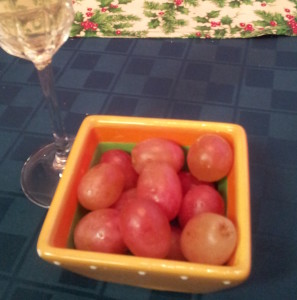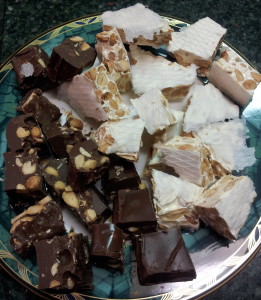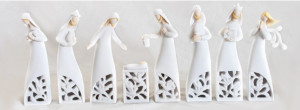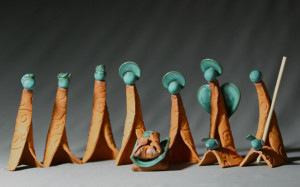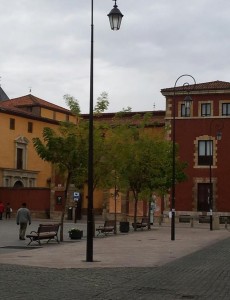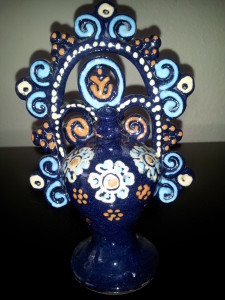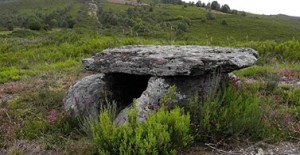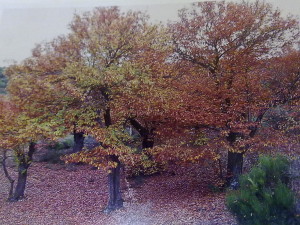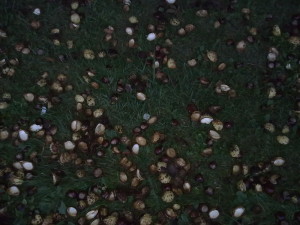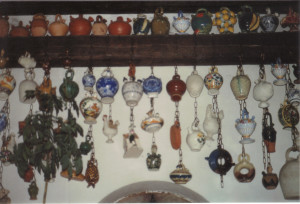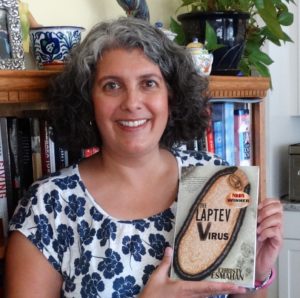¡Feliz Año! ¿Que tal las uvas? This is an expression that will be said thousands of times today in Spain. “Happy (New) Year! How were the grapes?” No, it’s not that everyone owns vineyards, and grapes are not code for anything else—they really do mean, “How were your grapes?”
To understand the question, allow me to paint a picture of how a typical Spanish New Year’s Eve goes: you get together at a relative’s house (or welcome all your relatives to yours) and begin with appetizers around 10:00 PM. It’s a bit early for dinner by Spanish standards, but it’s a long night so you have to get an early start. By 11 PM the main meal has been served, and at about 11:50 PM the table is quickly cleared and the grapes are brought out—either one big bowl or, more often, individual servings, depending on the customs of each house. A this point everyone turns their attention to the TV, which is tuned to the channel where they are filming live from the Puerta del Sol, a plaza in downtown Madrid (kind of like our Times Square in New York City) which is packed with people waiting to count down to the New Year. When the clock begins striking, everyone back at home picks up their little bowl with grapes and quickly pops one grape in their mouth with each strike of the clock.
Of course, after about the fifth or sixth grape it’s really difficult to keep adding them to your mouth and still try to chew–especially since the grapes are sometimes fairly large and always have seeds. It’s a fun and silly tradition and there are always hilarious stories about how many you could actually fit into your mouth and if you kept up with the chimes of the clock and if seeing your aunt or four-year-old niece stuffing her face full made you laugh so hard you ended up spitting yours out, and whether someone actually cheated by removing the seeds from their grapes in advance. I remember a person who would not only remove the pips, but also peel each grape so she could just swallow them quickly and get them all down before the clock struck twelve!
After the clock strikes midnight, there are the customary two kisses, one on each cheek, to everyone present, and then you return to the table for cava (Spanish champagne) and dessert, eventually followed by coffee. At around 1:30 or 2:00 AM everyone puts on coats and goes out for a stroll. The streets are packed with people, and you see lots of them making the gesture with their hands, palm upwards, and bringing their finger tips together with their thumbs as they marvel at how many people are out and about. Perhaps the really old folks will go back in around 3:30 or 4:00 AM, but most everyone else will be out till about 7:00 AM, at which time they’ll purchase chocolate con churros from the street vendors, and then finally head back home to go to bed. From about 9:00 AM until well after 3:00 PM the streets are absolutely deserted—the street cleaners have the whole place to themselves while the throngs that were out at 5:00 AM, are, of course, all sleeping away the first day of the New Year. I know. I’m not one to sleep late, even if I didn’t go to bed until after dawn, and I could not believe how desolate the streets were on that first day of the New Year.
But I digress. The unique custom of eating twelve grapes on New Year’s Eve began in Spain and was first documented in the late 1800’s according to Wikipedia. In 1894 it was already considered an “age-old” custom to gather in the Puerta del Sol and eat a grape for each of the twelve chimes. However, Euroresidentes states that it wasn’t until the first decade of the 1900’s when grape growers in southern Spain found that they had an unusually large harvest that they needed to market, that these producers made a concerted effort to have this custom of eating “twelve lucky grapes for a great new year” spread widely across Spain. Nowadays eating New Year’s Eve grapes as the clock tolls has been adopted in quite a few Latin American countries as well.
Another fun tidbit: until 1962, people listened to the twelve chimes as they were broadcast from Madrid over the radio, but after that, the event began to be featured on TV. Now, of course, it’s the big TV personalities who are often at the center of festivities ushering in the New Year and announcing the grape eating ritual.
So I hope your grapes went down well—or go well next year, if that’s the first time you try to eat them as the clock strikes. And most of all I hope you have a fantastic New Year 2014!
If you enjoyed this blog post, you might also like my series of novels, Bueno, Sinco and Brujas, which takes place in Santander, Spain.


